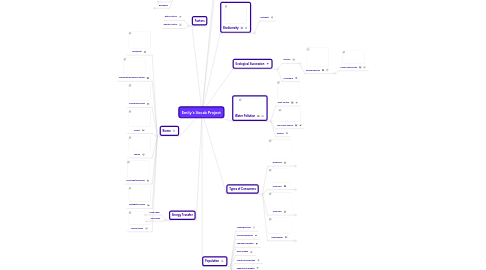
1. Biome
1.1. Rainforest
1.2. Temperate Deciduous Forest
1.3. Coniferous Forest
1.4. Desert
1.5. Tundra
1.6. Grassland/Savannah
1.7. Freshwater Biome
1.8. Marine Biome
2. Levels of Organization
2.1. Organism
2.1.1. Any living thing
2.2. Population
2.2.1. Group of individuals of the same species found in a given area or located in the same area at a given time.
2.3. Community
2.3.1. Populations of living organisms that interact with one another in an ecosystem.
2.4. Ecosystem
2.4.1. Group of living organisms that interact with one another and the non living physical environment as one unit.
2.5. Biome
2.5.1. Geographic regoin of Earth that is inhabited by a community of distinct types of plant and associated animal species.
2.6. Biosphere
2.6.1. Layer of soil, water, and air that sustains life.
3. Energy Transfer
3.1. Food Chain
3.1.1. How energy is transferred in ecosystems. The sequence in which energy is transferred though one organism to the next as it eats the other.
3.2. Food Web
3.2.1. Shows what an ecosystem really looks like. Shows that organisms eat a lot more than just one thing.
4. Factors
4.1. Biotic Factors
4.2. Abiotic Factors
5. Types of Consumers
5.1. Herbivore
5.1.1. Only eats plants
5.2. Carnivore
5.2.1. Only eats meat/animals
5.3. Omnivore
5.3.1. Eats both plants and animals
5.4. Decomposer
5.4.1. Breaks down dead organic material
6. Trophic Levels
6.1. Producer
6.1.1. Produces energy through photosynthesis, most important part of the food chain
6.2. Primary Consumer
6.2.1. Second part of the food chain, consumes the producer
6.3. Secondary Consumer
6.3.1. Third part of the food chain, consumes the primary consumer
6.4. Tertiary Consumer
6.4.1. Fourth part of the food chain, consumes the secondary consumer.
7. Biodiversity
7.1. Hotspots
8. Ecological Succession
8.1. Primary
8.1.1. Pioneer species
8.1.1.1. Climax community
8.2. Secondary
9. Population
9.1. Limiting factors
9.2. Carrying capacity
9.3. Population growth
9.4. Black Plague
9.5. Industrial Revolution
9.6. Exponential growth
9.7. Sustainability
9.8. Logistic growth
9.8.1. S-curve
